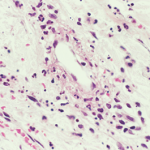Takayasu’s arteritis is like the other vasculitides, though, in that it is very uncommon—Dr. Bacon said there is only one case per million population in the U.K.—and in that its extremely challenging to diagnose. The inflammation can exist for many years, producing mild or non-specific symptoms, arthralgia or mylalgias until there is a evidence of serious vascular insufficiency such as claudication, angina or a major complication, such as stroke; aortic regurgitation may also occur because of valve involvement. The vast majority of patients with Takayasu’s arteritis are treated with prednisone.
Dr. Bacon discussed various factors to look for when diagnosing Takayasu’s arteritis. “The major factor, unfortunately, is pulse loss,” he said, though the disease can be detected using other tests before it progresses that far. Angiograms, which show narrowing or occlusion of the blood vessels, are currently the standard diagnostic test. But an angiogram “doesn’t tell you anything about what’s going on in the blood vessel wall, so it can’t distinguish disease activity from scars and is therefore a poor guide to therapy,” he explained. Recent studies have shown that advanced MRI can show wall thickening both in the aorta and in all the major arterial segments. “Therefore, this is a clear advance in assessing the degree of activity of the disease,” he said.
Virginia Hughes is a medical writer based in New York City.
